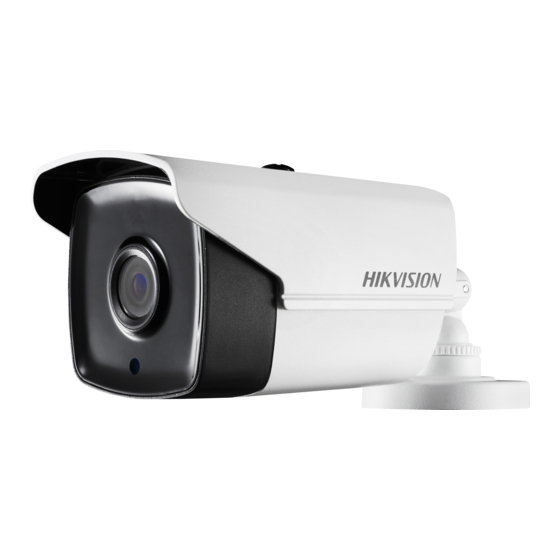
Table of Contents
Advertisement
Quick Links
D8T POC Series Bullet &
User Manual
Thank you for purchasing our product. If there are any
questions, or requests, do not hesitate to contact the
dealer.
This manual applies to the models below:
Type
Type I Camera
Type II Camera
Type III Camera
Type IV Camera
Type V Camera
Type VI Camera
This manual may contain several technical incorrect
places or printing errors, and the content is subject to
change without notice. The updates will be added to
the new version of this manual. We will readily improve
or update the products or procedures described in the
manual.
TURBO HD
Turret Camera
User Manual
Model
DS-2CE16D8T-IT1E
DS-2CE16D8T-IT3E
DS-2CE16D8T-IT5E
DS-2CE16D8T-IT3ZE
DS-2CE16D8T-ITE
DS-2CE56D8T-IT3ZE
DS-2CE56D8T-IT1E
DS-2CE56D8T-IT3E
DS-2CE56D8T-ITME
0100001081224
Advertisement
Table of Contents

Subscribe to Our Youtube Channel
Summary of Contents for HIKVISION TURBO HD D8T POC Series
- Page 1 TURBO HD D8T POC Series Bullet & Turret Camera User Manual User Manual Thank you for purchasing our product. If there are any questions, or requests, do not hesitate to contact the dealer. This manual applies to the models below: Type Model DS-2CE16D8T-IT1E...
-
Page 2: Regulatory Information
Regulatory Information FCC Information Please take attention that changes or modification not expressly approved by the party responsible for compliance could void the user’s authority to operate the equipment. FCC compliance: This equipment has been tested and found to comply with the limits for a Class A digital device, pursuant to part 15 of the FCC Rules. - Page 3 Safety Instruction These instructions are intended to ensure that user can use the product correctly to avoid danger or property loss. The precaution measure is divided into “Warnings” and “Cautions”. Warnings: Serious injury or death may occur if any of the warnings are neglected.
- Page 4 Keep the camera away from liquid while in use for non-water-proof device. While in delivery, the camera shall be packed in its original packing, or packing of the same texture. Mark Description Table 0-1 Mark Description Mark Description DC Voltage...
-
Page 5: Product Features
1 Introduction 1.1 Product Features The main features are as follows: High performance CMOS sensor IR cut filter with auto switch OSD menu with configurable parameters Auto white balance SMART IR Power over coaxial 3-Axis adjustment ... -
Page 6: Installation
1.2.5 Overview of Type V Camera Enclosure Main Body Power Cord DC12V Video Cable Mounting Base Figure 1-5 Overview of Type V Camera 1.2.6 Overview of Type VI Camera Clip Plate Mounting Base Enclosure Trim Ring Main Body Video Cable Power Cord Figure 1-6 Overview of Type VI Camera 2 Installation... - Page 7 Figure 2-1 The Drill Template 3. Route the cables through the cable hole, or the side opening. 4. Install the camera to the ceiling with supplied screws. Figure 2-2 Install the Camera to the Ceiling Note: The supplied screw package contains self-tapping ...
- Page 8 1. Paste the drill template (supplied) to the place where you want to install the camera. 2. Drill screw holes on the ceiling/wall according to the drill template. Figure 2-4 The Drill Template 3. Take apart the junction box, and align the screw holes of the camera with those on the Junction box’s cover.
- Page 9 9. Repeat the step 5 and 6 of 2.1.1 Ceiling/Wall Mounting to finish the installation. 2.2 Installation of Type IV/Type V/Type VI Camera 2.2.1 Ceiling/Wall Mounting Before you start: The installation steps of Type IV, Type V, and Type VI Camera are similar and the following takes Type IV as an example to describe the steps.
- Page 10 Figure 2-11 Assemble the Camera 7. Tighten the screws with the screw driver. 8. Connect the corresponding cables, such as power cord, and video cable. 9. Power on the camera to check whether the image on the monitor is gotten from the optimum angle. If not, adjust the camera according to the figure below to get an optimum angle.
- Page 11 4. Take apart the junction box, and align the screw holes of the camera with those on the junction box’s cover. 5. Install the mounting base to the junction box’s cover with three PM4 × 10 screws. Figure 2-14 Secure Screws on Junction Box’s Cover 6.
-
Page 12: Menu Description
3 Menu Description Follow the steps below to call the menu. Note: The actual display may vary with your camera model. Steps: 1. Connect the camera with the TVI DVR, and the monitor, shown as the figure 3-1. Figure 3-1 Connection 2. -
Page 13: Slow Shutter
1). Click up/down direction button to select the item. 2). Click Iris + to confirm the selection. 3). Click left/right direction button to adjust the value of the selected item. 3.1 FORMAT You can set the video format to 2MP@25fps or 2MP@30fps. -
Page 14: Video Settings
You can turn on/off the IR LIGHT to meet the requirements of different circumstances. SMART IR The Smart IR function is used to adjust the light to its most suitable intensity, and prevent the image from over exposure. The SMART IR value can be adjusted from 0 to 3. -
Page 15: Image Mode
IMAGE MODE IMAGE MODE is used to adjust the image saturation, and you can set it as STD (Standard), or HIGH-SAT (High Saturation). WHITE BALANCE White balance, the white rendition function of the camera, is to adjust the color temperature according to the environment. -
Page 16: Motion Det
3.5 FUNCTIONS MOTION DET In the user-defined motion detection surveillance area, the moving object can be detected and the alarm will be triggered. Up to 4 motion detection areas can be configured. MOTION DET Figure 3-6 MOTION DET Set the MODE to ON. Select a MOTION area, then set the X/Y position, and the size of the area according to your needs.







Need help?
Do you have a question about the TURBO HD D8T POC Series and is the answer not in the manual?
Questions and answers